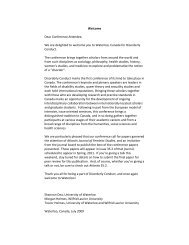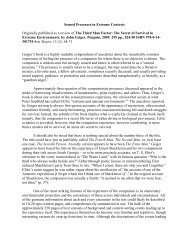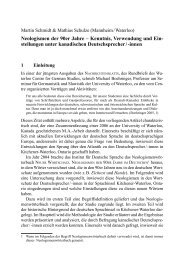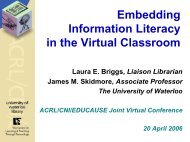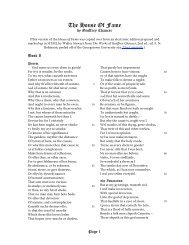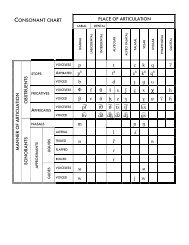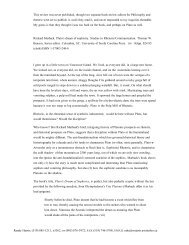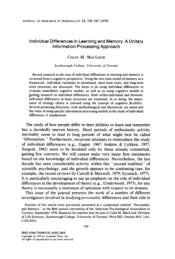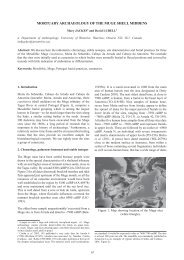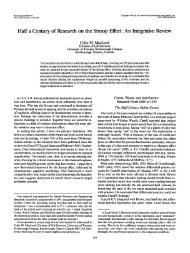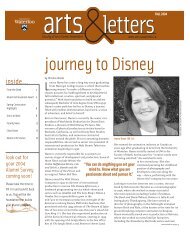The mid seventeenth century collapse of Iroquoian Ontario:
The mid seventeenth century collapse of Iroquoian Ontario:
The mid seventeenth century collapse of Iroquoian Ontario:
You also want an ePaper? Increase the reach of your titles
YUMPU automatically turns print PDFs into web optimized ePapers that Google loves.
M. JackeS<br />
366<br />
Again, refugees may be the part <strong>of</strong> the explanation <strong>of</strong> this aggregation <strong>of</strong> people in a specific,<br />
and perhaps special, centre.<br />
Certainly, the northern neighbours <strong>of</strong> the Neutral were beginning to flood into Neutralia.<br />
In 1647, 1649 and 1650, Huron and Petun survivors <strong>of</strong> war and famine fled to Neutral<br />
villages. For example, in the spring <strong>of</strong> 1649 “a goodly number” <strong>of</strong> the Huron took refuge with<br />
the Neutral (JR, 35, p. 79) 13 .<br />
<strong>The</strong> Neutral disappear from history<br />
For the most part, the Neutral had been protected from war by their neutrality, which<br />
extended to combatants visiting their territory, so that Neutral territory provided a type <strong>of</strong><br />
sanctuary. Sagard (1939, p. 158) recorded that both Huron and Iroquois must respect the<br />
neutrality <strong>of</strong> the Neutral lands to the extent that, if Huron and Iroquois met in Neutralia,<br />
“they did not dare to utter or do anything displeasing to one another when there, and <strong>of</strong>ten<br />
would even eat together as if they had been friends”.<br />
Despite this, in 1647, the northern Neutral were attacked by the Seneca. <strong>The</strong> Neutral had<br />
welcomed 300 Seneca warriors into their village. Trusting that the pact <strong>of</strong> neutrality and<br />
safety would be maintained, they took the Seneca into their longhouses and prepared food.<br />
But the Seneca proceeded to a massacre. Many Neutral were killed and many taken captive<br />
(JR, 33, p. 81). This act was in revenge for an incident <strong>of</strong> the previous winter (JR, 33, p. 83),<br />
when a Seneca who had committed murder was followed by Huron into a Neutral village<br />
and was captured before he had a chance to enter the sanctuary <strong>of</strong> a longhouse. <strong>The</strong> Seneca<br />
chose to view this as a breaking <strong>of</strong> the commitment to neutrality, presumably by the Neutral<br />
as well as by the Huron.<br />
<strong>The</strong> next incident was the rescue by the Neutral <strong>of</strong> a Huron girl who had escaped from<br />
the Seneca (JR, 33, p. 95). This was used by the Seneca as an excuse for a final break with the<br />
tradition <strong>of</strong> neutrality.<br />
Our knowledge <strong>of</strong> the end <strong>of</strong> the Neutral Nation is limited, because the Jesuits were<br />
forced to flee from <strong>Ontario</strong>. Events unfolded as follows. In March 1649, as described in<br />
volume 34 <strong>of</strong> the Jesuit Relations, the well-armed Iroquois fell in force upon the Huron. <strong>The</strong>y<br />
killed the old, the sick and the very young. Of the others, they captured as many as possible.<br />
Many villages were abandoned and some Huron fled to the village <strong>of</strong> the Jesuits at Ste Marie,<br />
where there were some stone buildings and firearms. But the famine at that time was the<br />
worst known, and eventually the Jesuits decided in August 1649 to burn their village and<br />
escape to an island. <strong>The</strong> cannibalizing <strong>of</strong> the dead, dug from their graves, described above,<br />
arose from the 1649 famine. <strong>The</strong> famine lasted into 1650, and was described as extreme and<br />
prevailing over all regions (JR, 34, p. 183). In March 1650, the cannibalism <strong>of</strong> the dead conti-<br />
13. I do not, however, suggest that Grimsby skeletons with analyzable dentitions are largely Huron/Petun.<br />
Analyses <strong>of</strong> non-metric dental traits distinguish the analyzable Grimsby teeth from, for example, those<br />
<strong>of</strong> the Huron buried at Maurice (Jackes, 1988). <strong>The</strong> cranial non-metric trait frequencies are different from<br />
other <strong>Ontario</strong> sites, suggesting a heterogeneous sample.



